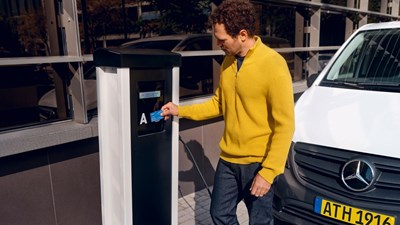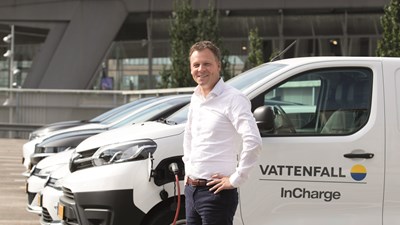“EVs will help boost the transition to fossil-free energy,” said Vattenfall’s Pieter van Ommeren in an earlier article in our ‘Digitalization and EV’ series. Diving deeper into this subject, we talked to high-voltage transmission system operator TenneT. And they couldn’t agree more. Read their view on how EVs can help balance power supply and demand – and technology like blockchain can facilitate the energy exchange.
If you’re living in the Netherlands or Germany, chances are high that TenneT ensures your energy supply. The company designs, builds, maintains and operates a high-voltage grid that delivers electricity to 43 million domestic and business users – across land, under the ground and under sea.
“Our task is to ensure the lights stay on and power is available whenever and wherever our customers need it. How we do that, is changing dramatically these days, as a result of Europe’s energy transition,” begins Axel Kiessling, Head of Strategy & Partnerships / Digital and Flex Development.

The challenges of today’s energy shift
He explains: “Electricity used to be generated mainly in conventional, big coal or gas power plants, which are connected to a network of high-voltage transmission lines. Yet, today’s race to decarbonization leads to a decentralization of power generation. The growing amount of renewable energy comes from an array of new, unconventional generation points that are scattered across wide distances, like wind turbines and solar panels on factories or residential homes.
What’s more, renewable energy production is highly weather-dependent. That means the availability varies and does not necessarily coincide with periods of high energy demand: there may be power scarcity or oversupply. Altogether, this makes balancing electricity production and consumption pretty challenging for us at TenneT.”
Flexibility services to help balance supply and demand
To illustrate his point, Axel zooms in on electricity supply in Germany: “All the offshore wind farms are located in the north of Germany. If there is surplus energy in the north and high demand in the south, it would be logical to transport the surplus of renewable energy to the south. Still, our electrical infrastructure is not ready to support such heavy traffic, leading to transport bottlenecks – like traffic jams on the highway. In that case, wind turbines are shut down temporarily, while we have to use expensive, conventional energy in the south.”
To manage all this, TenneT is upgrading its grid with new lines. Even though they are making great progress in grid expansion day by day, it takes time. “That’s why we also need ‘flexibility’ services that allow us to balance supply and demand,” says Axel. “The use of flexibilities makes perfect sense today and in the future. Also in a perfectly developed grid, flexible services help customers save money and reduce the impact on the environment.”
“Due to the growing number of decentralized energy generation points and the weather dependency of renewable energy production our way of working is changing dramatically.”
Axel Kiessling, Head of Strategy & Partnerships / Digital and Flex Development
EVs to power a more flexible grid
Here’s where electric vehicles have a role to play: they can help boost the flexibility that grid operators need, via:
-
Smart charging: As explained in an earlier article in the Digitalization & EV’s series, smart charging is all about intelligently managing how and when an EV is charged. Car owners can, for instance, indicate when they want their car to be charged or what minimum charge level they require and rely on the vehicle and charging software to communicate with the grid and choose the optimal charging process.
-
Energy storage and vehicle-to-grid: Increasingly, car batteries can also store electricity and feed it back to the grid when and where it’s needed most, via bi-directional chargers. OEMs and carmakers are currently working on bi-directional EVs that are able to both charge EVs and feed power back to the grid.
Beyond balancing supply and demand in the grid and thus creating stability, this could be a great way for EV owners to earn extra money. In a study that TenneT conducted with Daimler Truck AG, they found that companies with large truck fleets and buses could cut electricity costs by 30%.”

The huge potential of eVans, trucks and buses
Based on market-based projection, it is estimated that by 2030, there could be ca. 200,000 electric commercial vehicles (eLCVs) -or eVans- on German roads. Assuming that every van or truck has an available battery capacity between 350 and 600 kWh, that would result in a flexibility capacity of up to 1 gigawatt of electricity, enough to power 750,000 homes for an hour. By 2040, that amount is expected to triple to 600,000 eVans.
Learn more about eVans in our whitepaper.
How to integrate all these decentralized energy sources?
In the past few years, TenneT launched several successful tests with car makers like Nissan to investigate how EVs could contribute to the stability of the electricity grid. In a pilot project with Nissan, for example, wind power from northern Germany was used by electric cars in that region, while electricity from EVs was fed back into the grid. The results were promising.
Still, that was a pilot with a limited number of vehicles. Things get more complex when there is a large number of decentralized energy sources involved, says Axel: “We expect around 15 million EVs on the German roads by 2030. Managing that large number of distributed flexibility sources will be much harder than controlling the electricity of power plants.
Building an ecosystem, powered by blockchain
To be able to provide the required flexibility services, transmission system operators like TenneT need forecasts and data from a wide array of sources and parties: smart meters, distribution system operators, utilities, energy suppliers and even OEMs, car makers and lease companies, like Athlon.
To share data throughout the ecosystem, TenneT is experimenting with blockchain: a shared digital ledger that facilitates the process of recording transactions and tracking assets in a peer-to-peer network. “Blockchain technology ensures easy, secured and standardized data exchange,” Axel explains: “The European crowd balancing platform, Equigy, that we are working on together with 5 other transmission system operators, uses blockchain to swap trusted data in our ecosystem. In this way, it will become easy to integrate energy from EVs and other decentralized sources into the energy system on a large scale.”
EVs as enablers of the energy transition
In conclusion, TenneT is hopeful for the future: “People keep seeing the growing number of EVs on the road as a potential problem for the grid. Yes, there are challenges to tackle, but we focus on the potential benefits: e-mobility is an enabler of the energy transition and a source for flexibility in the grid. It brings us closer to our vision of a carbon-free future.”
How will flexibility services impact you and Athlon?
Ronald Slooten, eMobility Program Manager at Athlon, explained it in the first article in this series: all these innovations will require structural changes from everyone involved, including you as a fleet manager, drivers themselves and leasing companies like Athlon: “More than just practical implications, there will be a need for ethical discussions, too. Can drivers feed power back into the grid from their leased vehicles, for example? Can they then earn money with it, or can somebody else in the value chain claim their share? And who owns the data of today’s smart EVs: the manufacturer, the leasing company, the fleet owner or the drivers themselves?”
Stay on track
Dive deep into these articles. You’ll be inspired by new approaches and solutions for your mobility challenges.




